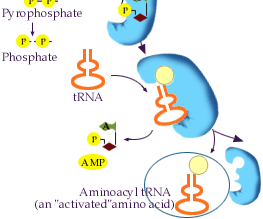|
|
Amino Acid Activation During amino acid activation the amino acids (aa) are attached to their corresponding tRNA. The coupling reactions are catalysed by a group of enzymes called aminoacyl-tRNA synthetases (named after the reaction product aminoacyl-tRNA or aa-tRNA). The coupling reaction proceeds in two steps: 1. aa + ATP The amino acid is coupled to the penultimate nucleotide at the 3’-end of the tRNA (the A in the sequence CCA) via an ester bond (roll over in illustration). The formation of the ester bond conserves a considerable part of the energy from the activation reaction. This stored energy provides the majority of the energy needed for peptide bond formation during translation. Each of the 20 amino acids are recognised by its
specific aminoacyl-tRNA synthetase. The synthetases
are usually composed of one to four protein subunits.
The enzymes vary considerably in structure although
they all perform the same type of reaction by binding
ATP, one specific amino acid and its corresponding
tRNA. |
||||||

